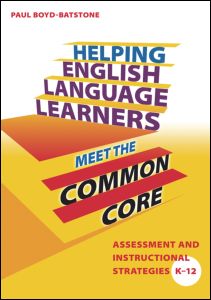Helping English Language Learners Meet the Common Core
Helping English Language Learners Meet the Common Core
By Paul Boyd-Batstone
(Eye on Education/Routledge, 2013 – Learn more)

There are many aspects to the Common Core that are unsettling to a lot of teachers and school administrators, not the least is how the coming PARCC and Smarter Balance assessment tools will play out with English Language Learners and students on educational plans.
This book – Helping English Language Learners Meet the Common Core – provides some practical advice for teachers with ELL students, but the title is a bit deceptive in that the focus here is almost entirely the listening and speaking standards of the Common Core.

That said, there is plenty in this book that can help teachers find focus in meeting the language needs of English Language Learners. Boyd-Batstone focuses on a heuristic tool known as Classroom Assessment of Language Levels (CALL), which is a formative assessment strategy that helps identify student language proficiency levels.
CALL is organized around categories of stages of language development, interactive questioning techniques, student behavior guideposts and more. Handy charts show a range of student behaviors around various levels, as well as differentiated instructional techniques, plus strategies for small group instruction and intervention around speaking and listening.
Boyd-Batstone lays out a series of chapters related to the levels of proficiency, so that a reader can skip around to find activities and guideposts to student growth. The book’s focus on speaking and listening makes a lot of sense when one thinks of how to nurture the literacy skills of ELL students. But I still think it would have been helpful to have that message clear on the cover of this book, so that teachers know what they are getting. And not getting.
Kevin Hodgson is a sixth grade teacher in Southampton, Massachusetts, and is the technology liaison with the Western Massachusetts Writing Project. He blogs regularly at Kevin’s Meandering Mind and tweets more often than is healthy under his @dogtrax handle. Kevin is also MiddleWeb’s new ELA blogger, at Working Draft.


































